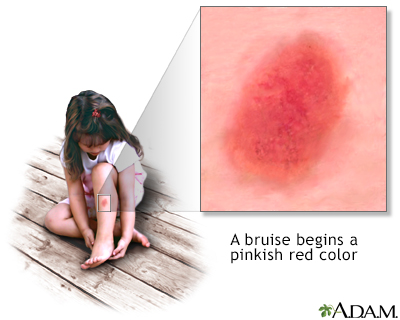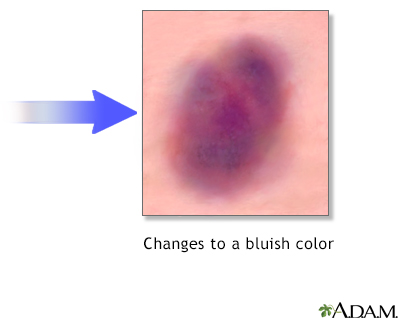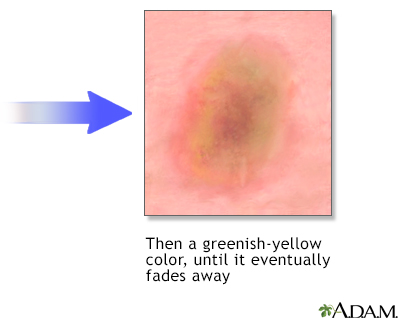Bruise
Contusion; HematomaA bruise is an area of skin discoloration. A bruise occurs when small blood vessels break and leak their contents into the soft tissue beneath the skin.
Considerations
There are three types of bruises:
- Subcutaneous -- beneath the skin
- Intramuscular -- within the belly of the underlying muscle
- Periosteal -- bone bruise
Bruises can last from days to months. A bone bruise is the most severe and painful.
Causes
Bruises are often caused by falls, sports injuries, car accidents, or blows received from other people or objects.
If you take a blood thinner, such as aspirin, warfarin (Coumadin, Jantoven), dabigatran (Pradaxa), rivaroxaban (Xarelto), apixaban (Eliquis), or clopidogrel (Plavix), you are likely to bruise more easily.
Symptoms
Main symptoms are pain, swelling, and skin discoloration. The bruise begins as a pinkish red color that can be very tender to touch. It is often difficult to use the muscle that has been bruised. For example, a deep thigh bruise is painful when you walk or run.
Eventually, the bruise changes to a bluish color, then greenish-yellow, and finally returns to the normal skin color as it heals.
First Aid
- Place ice on the bruise to help it heal faster and to reduce swelling. Wrap the ice in a clean towel. Do not place ice directly on the skin. Apply the ice for up to 15 minutes each hour.
- Keep the bruised area raised above the heart, if possible. This helps keep blood from pooling in the bruised tissue.
- Try to rest the bruised body part by not overworking your muscles in that area.
- If needed, take acetaminophen (Tylenol) to help reduce pain.
In the rare case of compartment syndrome, surgery is often done to relieve the extreme buildup of pressure. Compartment syndrome results from increased pressure on the soft tissues and structures beneath the skin. It can decrease the supply of blood and oxygen to the tissues.
Compartment syndrome
Acute compartment syndrome is a serious condition that involves increased pressure in a muscle compartment. It can lead to problems with blood flow ...

Do Not
- Do not try to drain the bruise with a needle.
- Do not continue running, playing, or otherwise using the painful, bruised part of your body.
- Do not ignore the pain or swelling.
When to Contact a Medical Professional
Contact your health care provider right away if you feel extreme pressure in a bruised part of your body, especially if the area is large or very painful. This may be due to compartment syndrome, and can be life-threatening. You should receive emergency care.
Also contact your provider if:
- You are bruising without any injury, fall, or other reason.
- There are signs of infection around the bruised area including streaks of redness, pus or other drainage, or fever.
Prevention
Because bruises are usually the direct result of an injury, the following are important safety recommendations:
- Teach children how to be safe.
- Be mindful to avoid falls around the house. For example, be careful when climbing on ladders or other objects. Avoid standing or kneeling on counter tops.
- Wear seat belts in motor vehicles.
- Wear proper sports equipment to pad those areas most frequently bruised, such as thigh pads, hip guards, and elbow pads in football and hockey. Wear shin guards and knee pads in soccer and basketball.
References
Buttaravoli PM, Leffler S, Herrington RR. Contusion: (bruise). In: Buttaravoli PM, Leffler S, Herrington RR, eds. Minor Emergencies. 4th ed. Philadelphia, PA: Elsevier; 2022:chap 134.
Cameron P, O'Reilly G. Trauma overview. In: Cameron P, Little M, Mitra B, Deasy C, eds. Textbook of Adult Emergency Medicine. 5th ed. Philadelphia, PA: Elsevier; 2020:chap 3.1.
Schafer AI. Approach to the patient with bleeding or thrombosis. In: Goldman L, Schafer AI, eds. Goldman-Cecil Medicine. 27th ed. Philadelphia, PA: Elsevier; 2024:chap 157.
-
Bone bruise - illustration
A bone bruise results from compressive forces incurred during an injury. The damaged area occurs in the medullary portion of the bone and can be accompanied by bleeding and swelling. Bruises are often caused by falls, sports injuries, car accidents, or blows from other people or objects. Bruises can last from days to months, with the bone bruise being the most severe and painful.
Bone bruise
illustration
-
Muscle bruise - illustration
A muscle bruise occurs when a direct blow from an object strikes part of the body, damaging the underlying muscle fibers and connective tissue without breaking the skin. A muscle bruise can cause pain and swelling and limited range of motion of the joint near the injury. Depending upon the extent of injury, a muscle bruise can take days or months to heal.
Muscle bruise
illustration
-
Skin bruise - illustration
A bruise occurs when a force causes blood vessels to break. Blood leaks into areas under the skin, resulting in pain, swelling, and skin discoloration.
Skin bruise
illustration
-
Bruise healing - series
Presentation
-
Bone bruise - illustration
A bone bruise results from compressive forces incurred during an injury. The damaged area occurs in the medullary portion of the bone and can be accompanied by bleeding and swelling. Bruises are often caused by falls, sports injuries, car accidents, or blows from other people or objects. Bruises can last from days to months, with the bone bruise being the most severe and painful.
Bone bruise
illustration
-
Muscle bruise - illustration
A muscle bruise occurs when a direct blow from an object strikes part of the body, damaging the underlying muscle fibers and connective tissue without breaking the skin. A muscle bruise can cause pain and swelling and limited range of motion of the joint near the injury. Depending upon the extent of injury, a muscle bruise can take days or months to heal.
Muscle bruise
illustration
-
Skin bruise - illustration
A bruise occurs when a force causes blood vessels to break. Blood leaks into areas under the skin, resulting in pain, swelling, and skin discoloration.
Skin bruise
illustration
-
Bruise healing - series
Presentation
Review Date: 4/27/2023
Reviewed By: Linda J. Vorvick, MD, Clinical Professor, Department of Family Medicine, UW Medicine, School of Medicine, University of Washington, Seattle, WA. Also reviewed by David C. Dugdale, MD, Medical Director, Brenda Conaway, Editorial Director, and the A.D.A.M. Editorial team.









